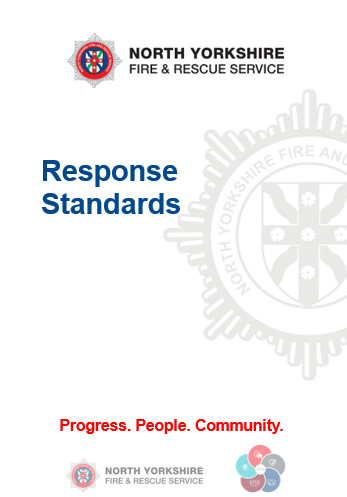Background information – NYFRS Response Standards
Why are we creating response standards?
We plan to implement new response standards. The new response standards are not changes to the way we provide our emergency response function but aim to improve the transparency and performance of our emergency response. Most of the Fire and Rescue Services in England have response standards and North Yorkshire received the following Area for Improvement from HMICFRS[1] following our 2021/22 inspection,
“The service should publish its expected response standards so the public can compare expected performance against actual performance.”
Extensive work has been undertaken to determine what these standards should be and how they should be presented. We’re providing our communities and stakeholders the opportunity to be consulted on them. We welcome your views, which you can share through our survey.
This document is designed to provide you with background information and context to help you respond to the consultation.
What is a response standard?
A response standard is a commitment to respond to incidents within set timescales. To align to Home Office reporting, we aim to commit to responding to certain incident types within a set time. Our new response standards will be the time it takes us to respond to the following,
- Dwelling Fires. The Home Office defines dwelling fires as ‘fires in properties that are a place of residence that is, places occupied by households such as houses and flats, excluding hotels/hostels and residential institutions; dwellings also includes non-permanent structures used solely as a dwelling, such as houseboats and caravans’ (Home Office fire statistics definitions)
- All Incidents. This will be the time taken to respond to all types of incident which includes attendance to false alarms, special services (non-fire incidents such as road traffic collisions and flooding), as well as fires. Additional to dwelling fires this includes other primary fires such as fires in non-residential buildings, road vehicles, outdoor fires and secondary fires.
Dwelling fires are addressable, time critical and typically happen nearer to where we have fire stations. We will therefore set a more ambitious standard for these incidents and aim to provide a quicker response.
As North Yorkshire is such a large and varied county, a set response standard to every individual incident cannot be provided. Further information about our Service area can be found in our Risk and Resource Model[2]. We must prioritise our resources to areas of higher risk and response times will vary between high and low risk areas. We also operate different duty systems in different parts of the county which impact on local response times. A response standard is a service wide measure based on either our mean average response time or our response to incidents in a timescale, a certain percentage of the time.
What is a response time?
A response time is made up of different parts, but to align to Home Office reporting we measure our full response time, which is the time taken from 999 call to the first fire engine (or other fire service vehicle) arriving (in attendance) at an incident. The graphic below is produced by the Home Office and shows the individual measurable elements which collectively make a ‘total response time’. As a Service, we have introduced performance indicators for each component part including the call handling times in our control room, but for our response standard we are consulting on the total response time.

Response times nationally
Nationally the Home Office has reported a gradual increase in Fire and Rescue response times over the last decade. The graphic below is taken from the annual Home Office report on Fire and Rescue response times. The graphic shows that up until 2023/24, the Fire and Rescue sector has seen gradual increases in response times. North Yorkshire is classed as a predominantly rural service.

Source: Home Office detailed analysis of fires attended and response times by fire and rescue services, England, April 2023 to March 2024 Fig 8.2 (published September 2024) Detailed analysis of fires attended and response times by fire and rescue services, England, April 2023 to March 2024 – GOV.UK (www.gov.uk)
Response times locally
Similar to the national trends, we have experienced similar trends in changes to response times. During 2022/23, our average response times to all primary fires exceeded 13 minutes. The graphic below shows the change in our response times over the last ten years.

Source: FIRE1001: Average response times by location and fire and rescue authority, England (Home Office Fire Statistics Fire statistics data tables – GOV.UK (www.gov.uk))
In 2023, we implemented a response times improvement plan with actions to support and improve each component part of our total response times. The early signs are positive and over 2023/24, we improved our response times to primary fires[3] more than any other Fire and Rescue Service in England. The figure to the right shows the year-on-year changes between Fire and Rescue Services in England. The Home Office data shows a reduction from 13 minutes 4 seconds in 2022/23 to 12 minutes 7 seconds in 2023/24.

Source: Home Office detailed analysis of fires attended and response times by fire and rescue services, England, April 2023 to March 2024 Fig 8.1 (published September 2024) Detailed analysis of fires attended and response times by fire and rescue services, England, April 2023 to March 2024 – GOV.UK (www.gov.uk)
Proposed response standards
Whilst we saw a positive improvement in our response times last year, we still want to set new response standards to ensure sustained improvement. Having response standards will help us to drive improvement and help the public and stakeholders to hold us to account. It also provides openness and honesty with our communities about the level of service they can expect.
The methodology for both options set out below is used in other fire and rescue services across England. We want the standards we set to be achievable but ambitious and have set out two different options for you to consider.
Option 1: is to present the standard as an average across the whole service area of York and North Yorkshire, for both dwelling fires (fires in the home) and all incidents.
- Dwelling Fires – Average attendance time of 1st fire engine will be within 11 minutes
- All incidents – Average attendance time of 1st fire engine will be within 13 minutes
This standard is more ambitious than some other predominantly rural fire and rescue services, who cover a much smaller geographic area.
The benefits of this option are that it is more transparent as it includes all our attendance times across the whole service area, including to incidents in our most rural communities, where travel times are unavoidably longer.
It also aligns to national recording of statistics gathered by the Home Office and His Majesty’s Inspectorate of Constabularies and Fire and Rescue Services, to allow better benchmarking with other similar services.
Option 2: is to present the standard for dwelling fires and all incidents as a time standard that we will achieve on 80% of occasions.
- Dwelling Fires – 1st fire engine will attend within 11 minutes on 80% of occasions
- All incidents – 1st fire engine will attend within 13 minutes on 80% of occasions
The benefit of this option is that it shows the public the number of times we have met the agreed standard. However, this is not as transparent since it does not take into account response times to incidents in our most rural communities, where travel times are unavoidably longer.
It doesn’t align to national recording of statistics gathered by the Home Office and His Majesty’s Inspectorate of Constabularies and Fire and Rescue Services so makes it more difficult to benchmark performance with similar services.
Response standards in other predominantly rural Fire and Rescue Services
There is no set way in which a fire and rescue service should record and report response standards, but a few examples are highlighted below. All of the Fire and Rescue Services in the table are in our family group and defined as predominantly rural fire and rescue services by the Home Office and HMICFRS.
| Service | Performance Measure |
| Lincolnshire Fire and Rescue Service | · Respond to dwelling fires within an average of 11 minutes for the first fire engine
· Respond to all other incidents within an average of 15 minutes for the first fire engine |
| Cumbria Fire and Rescue Service | · Attend 80% of property fires within 10 minutes (1st fire engine)
· Attend 80% of all other incidents within 15 minutes (1st fire engine) |
| Devon & Somerset Fire and Rescue Service | · Attend 75% of dwelling fires within 10 minutes.
· Attend 75% of RTC’s within 15 minutes |
| Norfolk Fire and Rescue Service | · 80 % of fires where life may be at risk within 10 minutes
· 80% of other emergencies where life may be at risk within 13 minutes |
| Shropshire Fire and Rescue Service | · The Service aims to get at least four firefighters to any incident, in any part of the county, within 15 minutes on 89% of occasions |
| Suffolk Fire and Rescue Service | · Attend 80% of property fires within 11 minutes of alert. (1st Fire Engine) |
Summary
Setting response standards will assist our ability to drive improvement in emergency response. It will also help us measure our performance against a set standard and be held to account on the level of service we can provide.
We welcome your views on which performance measure is most meaningful and easy to understand. Please take the time to complete our response standards survey and support this process.
Download
North Yorkshire Fire & Rescue Service
Headquarters
Alverton Court
Crosby Road
Northallerton
North Yorkshire
DL6 1FE
Tel: 01609 780 150
www.northyorksfire.gov.uk
[1] His Majesty’s Inspectorate of Constabulary and Fire and Rescue Services is an independent inspectorate of Police Forces and Fire and Rescue Services in England
[2] NYFRS Risk and Resource Model: https://www.northyorksfire.gov.uk/about-us/who-and-what/plans-and-reports/risk-and-resource-model-2022-2025/
[3] Primary fires are defined by the Home Office as Potentially more serious fires that cause harm to people or damage to property. To be categorised as primary these fires must either occur in a (non-derelict) building, vehicle or (some) outdoor structures, involve fatalities, casualties or rescues or be attended by 5 or more pumping appliances

